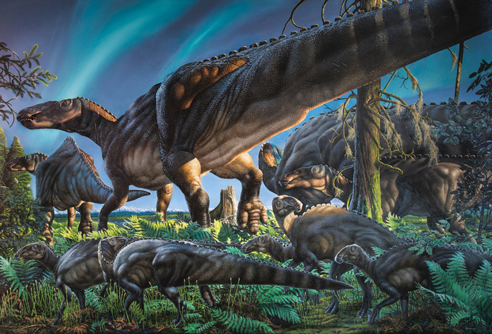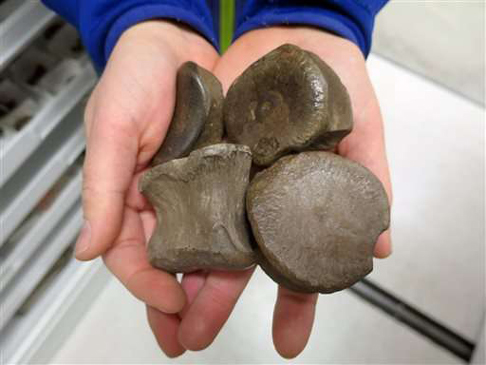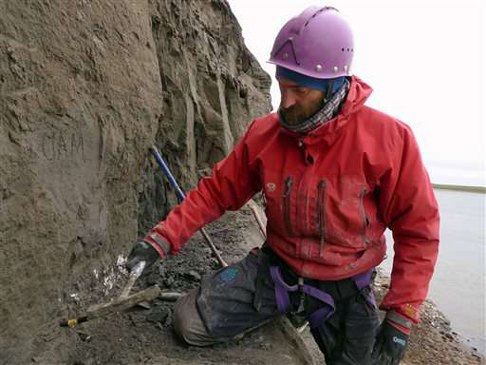Latest Dinosaur from Alaska
New Dinosaur Species Suggests Unique Fauna of Late Cretaceous Alaska (Ugrunaaluk kuukpikensis)
Scientists have announced a new species of duck-billed dinosaur that once roamed the polar forests of Alaska. The dinosaur, named Ugrunaaluk kuukpikensis pronounced 00-grew-na-luck kook-pik-en-sis, reached lengths in excess of nine metres and its discovery further supports the theory that during the Late Cretaceous, Alaska supported a unique dinosaur fauna.
An Illustration of a Herd of Ugrunaaluk (U. kuukpikensis)
Picture credit: James Havens
Ugrunaaluk kuukpikensis
The fossils, which include the remains of a number of individuals, came from the Liscomb Bone Bed, a highly fossiliferous layer of rock along the Colville River in the Prince Creek Formation. These rocks consist of flood plain deposits and shed light on life in the far north of the American continent some 69 million years ago (Maastrichtian faunal stage).
The Colville River area has produced evidence of a number of dinosaur species that suggest that the wildlife existing at the very top of the landmass known as Laramidia at the end of the Age of Dinosaurs was not found anywhere else in the world. Recent fossil finds include teeth of giant troodontids and a polar tyrannosaur.
To read more about the tyrannosaurid discovery: Nanuqsaurus – Polar Bear Lizard.
One of the lead authors of the scientific paper that details this discovery (published in the quarterly journal Acta Palaeontologica Polonica), Pat Druckenmiller stated:
“Today we find these animals in polar latitudes. Amazingly, they lived even farther north during the Cretaceous. These were the northern-most dinosaurs to have lived during the Age of Dinosaurs. They were truly polar.”
Earth sciences curator at the University of Alaska Museum of the North, Dr Druckenmiller worked with University of Alaska Fairbanks graduate student Hirotsugu Mori and Florida State University’s Gregory Erickson in order to piece together the fossilised and disarticulated remains. However, the naming of this dinosaur involved Ronald Brower Senior, an expert on Alaskan native peoples. The scientists wanted to give their new dinosaur a name that honoured the Iñupiaq people who live along the Colville River.
Honouring the Iñupiaq People
Mr Brower, a teacher at the University of Alaska Fairbanks Alaska Native Language Centre and an expert on the culture and history of the Iñupiaq, helped the team come up with Ugrunaaluk kuukpikensis, the name translates as “ancient grazer”, a reference to the extensive dental battery these dinosaurs possessed, vital if they were able to cope with a diet of coarse pine needles, fir cones and ferns.
Some of the Duck-Billed Dinosaur Fossil Bones from the Site
Picture credit: Pat Druckenmiller/University of Alaska Museum of the North
Permanent Residents?
Although the Arctic is much colder today than it was back in the Late Cretaceous, these dinosaurs, if they had been permanent residents*, would have endured many months of complete darkness and an average annual temperature of around nine degrees, that’s about the equivalent annual average temperature of Toronto (Ontario, Canada) today. These substantial herbivores would have been well used to seeing snow and ice.
Dr Pat Druckenmiller Digging for Dinosaur Fossils
Picture credit: Greg Erickson/University of Alaska Museum of the North
Ugrunaaluk kuukpikensis – An Important Discovery
This is the fourth unique dinosaur species to be identified from this part of the world. The researchers propose that these dinosaurs were specially adapted to survive the harsh climate and that northern Laramidia supported a unique ecosystem. The absence of any crocodile, lizard or turtle bones from the deposit suggests that ectotherms (cold-blooded reptiles) could not cope with the cold at this latitude.
*As to whether these duck-billed dinosaurs were residents or seasonal migrants has caused some debate amongst palaeontologists. Some scientists have proposed that these large herbivores migrated up to these latitudes so that they could take advantage of the abundant plant growth in the summer months, when there would have been almost permanent daylight. However, Greg Erickson believes that the young hadrosaurs found at the site were too small to be able to undertake such an extremely long migration. He thinks that the dinosaurs were permanent residents.
The Florida State University scientist explained these dinosaurs may have had physiologies more like birds or mammals. The researchers hope to study the fossils in more detail so that they can understand more about how such large reptiles were able to survive so far north.
As to where Ugrunaaluk kuukpikensis fits into the hadrosaur family tree, the dinosaur resembles an Edmontosaurus, but it was ascribed its own genus based on differences in the anatomy of the skull and differences in the morphology of some of the other post cranial fossil material.




